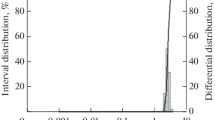Abstract—
This paper presents experimental data illustrating the effect of viscosity modifiers on the structure formation in cement systems and their rheological characteristics and strength. It is shown that SiO2- and Al2O3 · SiO2-based nano- and microparticles, similar in crystal-chemical structure to newly formed hydrate phases, are the most effective viscosity modifiers, capable of reducing the setting and hardening times by a factor of 1.3–1.5 and raising the plastic strength of the cement systems by four to five times and their compressive strength by 30%. Xanthan gum and potassium pyrophosphate are effective modifiers for controlling the rheological characteristics of the cement systems, but they are incapable of activating structure formation and hardening processes.



Similar content being viewed by others
REFERENCES
Paul, S.C., Tay, Y.W.D., Panda, B., and Tan, M.J., Fresh and hardened properties of 3D printable cementitious materials for building and construction, J. Arch. Civil Mech. Eng., 2018, vol. 18, no. 1, pp. 311–319.https://doi.org/10.1016/j.acme.2017.02.008
Zhang, Y., Zhang, Y., She, W., Yang, L., et al., Rheological and harden properties of the high-thixotropy 3D printing concrete, Constr. Build. Mater., 2019, vol. 201, pp. 278–285.https://doi.org/10.1016/j.conbuildmat.2018.12.061
Lu, B., Weng, Y., Li, M., and Qian, Y., A systematical review of 3D printable cementitious materials, Constr. Build. Mater., 2019, vol. 207, pp. 477–490.https://doi.org/10.1016/j.conbuildmat.2019.02.144
Le, T.T., Austin, S.A., Lim, S., Buswell, R.A., Gibb, A.G.F., and Thorpe, T., Mix design and fresh properties for high-performance printing concrete, Mater. Struct., 2012, vol. 8, no. 45, pp. 1221–1232.https://doi.org/10.1617/s11527-012-9828-z
Ngo, T.D., Kashani, A., Imbalzano, G., Nguyen, K., and Hui, D., Additive manufacturing (3D printing): a review of materials, methods, applications and challenges, Composites, Part B, 2018, vol. 143, pp. 172–196.https://doi.org/10.1016/j.compositesb.2018.02.012
Mechtcherine, V., Bos, F.P., Perrot, A., Leal da Silva, W.R., Nerella, V. N., Fataei, S., Wolfs, R.J.M., Sonebi, M., and Roussel, N., Extrusion-based additive manufacturing with cement-based materials – production steps, processes, and their underlying physics: a review, Cem. Concr. Res., 2020, vol. 132, paper 106037.https://doi.org/10.1016/j.cemconres.2020.106037
Slavcheva, G.S. and Artamonova, O.V., Rheological behavior of 3D printable cement paste: criterial evaluation, Mag. Civ. Eng., 2018, no. 8, pp. 97–108.https://doi.org/10.18720/MCE.84.10
Slavcheva, G.S. and Artamonova, O.V., Rheological behavior and mix design for 3d printable cement paste, Key Eng. Mater., 2019, vol. 799, pp. 282–287.https://doi.org/10.4028/www.scientific.net/KEM.799.282
Artamonova, O.V., Sintez nanomodifitsiruyushchikh dobavok dlya tekhnologii stroitel’nykh kompozitov (Synthesis of Nanomodifier Additives for the Technology of building Composites), Voronezh: Voronezhsk. Gos. Arkhitekturno-Stroitel’nyi Univ., 2016, 100 p.
Lootens, D., Joussett, O., Matinie, L., Roussel, N., and Flatt, R.J., Yield stress during setting of cement pastes from penetration test, Cem. Concr. Res., 2009, vol. 39, pp. 401–408.https://doi.org/10.1016/j.cemconres.2009.01.012
Bullard, J.W., Jennings, H.M., Livingston, R.A., Nonat, A., Scherer, G.W., Schweitzer, J.S., Scrivener, K.L., and Thomas, J.J., Mechanisms of cement hydration, Cem. Concr. Res., 2011, vol. 41, pp. 1208–1223.https://doi.org/10.1016/j.cemconres.2010.09.011
ACKNOWLEDGMENTS
The experimental data in this work were obtained using equipment at the Y.M. Borisov Shared Research Facilities Center, Voronezh State Technical University.
Author information
Authors and Affiliations
Corresponding author
Rights and permissions
About this article
Cite this article
Slavcheva, G.S., Artamonova, O.V., Shvedova, M.A. et al. Effect of Viscosity Modifiers on Structure Formation in Cement Systems for Construction 3D Printing. Inorg Mater 57, 94–100 (2021). https://doi.org/10.1134/S0020168521010143
Received:
Revised:
Accepted:
Published:
Issue Date:
DOI: https://doi.org/10.1134/S0020168521010143



